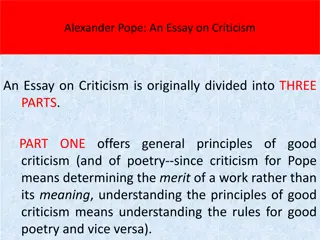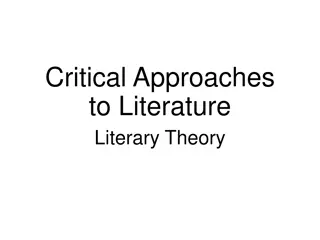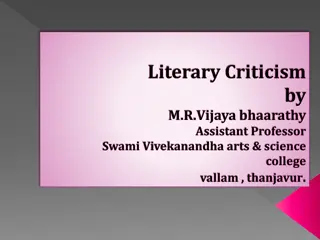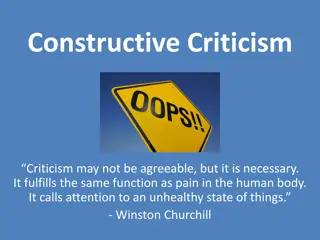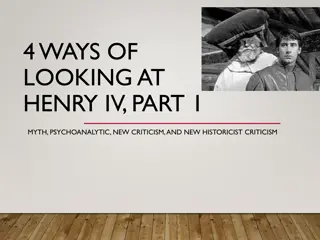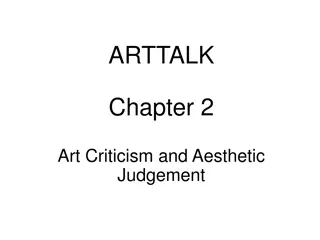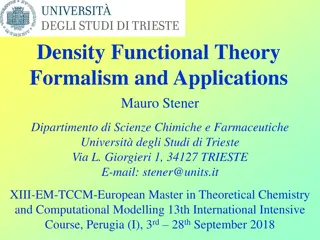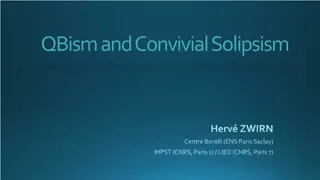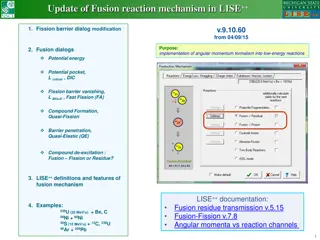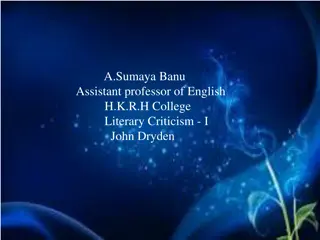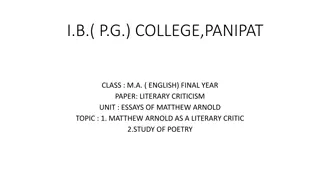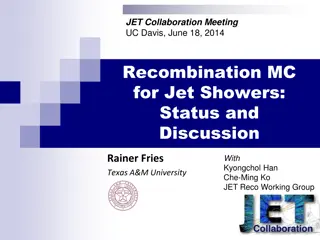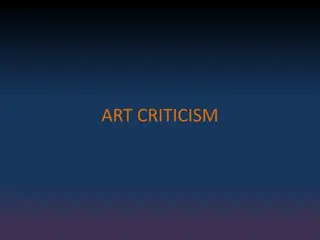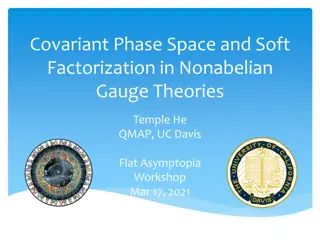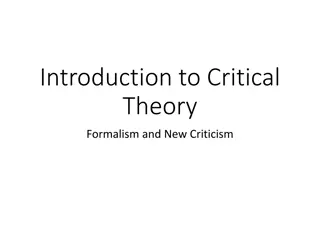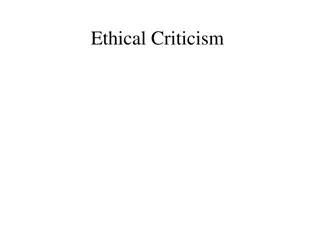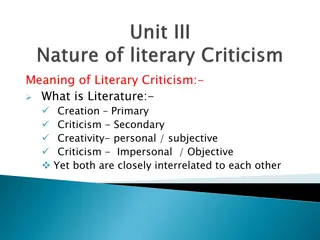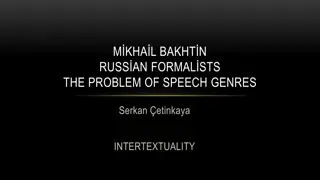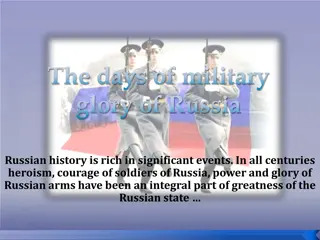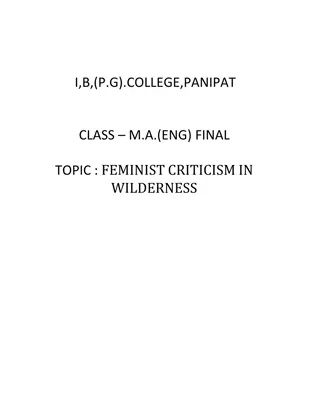Russian Formalism and American New Criticism Overview
Russian Formalism, a literary movement that emerged in the early 20th century, was a radical departure from traditional approaches to literary analysis. It sought to define literary criticism as a scientific profession, focusing on the autonomy of literature and employing linguistics for support. The formalists, including influential figures like Viktor Shklovsky, emphasized literariness over historical or national contexts, leading to a unique perspective on the nature of art. This summary touches upon the key concepts and figures associated with Russian Formalism and its impact on literary theory.
Download Presentation

Please find below an Image/Link to download the presentation.
The content on the website is provided AS IS for your information and personal use only. It may not be sold, licensed, or shared on other websites without obtaining consent from the author. Download presentation by click this link. If you encounter any issues during the download, it is possible that the publisher has removed the file from their server.
E N D
Presentation Transcript
Russian Formalism and American New Criticism
Basic Points It emerged in the mid-1910s and peaked by the early 1920s; its formal end was marked by an article of enforced self-criticism by Viktor Shklovsky, Monument to a Scholarly Error (1930). First attempt to strictly define literary criticism as a profession, including its object of analysis as well as its methods of proceeding like any other science (!). The formalists were the first to see lit. as an autonomous domain of theoretical inquiry, steering away from aesthetics, sociology, psychology, and history and seeking support in linguistics.
Burdens of History Russian literary criticism in the nineteenth century literature is the essence of a nation's history Censorship both in tsarist and Soviet Russia The formalists were allies of the Futurists and they included linguists, literary historians, and critics, but also poets. They were born mostly in the 1890s, came to prominence during World War I, established themselves institutionally after the Communist revolution, and became marginalized with the rise of Stalinism in the late 1920s.
Reduction Art is not concerned, for them, with nation or history, it is not representative of anything. Shklovsky: art is outside emotion , is without or outside compassion ; art was always apart from life and its colour never reflected the colour of the flag that waved over the fortress of the city . A radical departure from the mimetic theory of art. Literature is not an emanation of the author's soul, nor a socio-historical document, or a manifestation of a philosophical system.
Independent Literary Science Boris Eikhenbaum: what unites the formalists is the striving to establish, on the basis of specific properties of the literary material, an independent literary science . Roman Jakobson: Until now, the literary historian has looked like a policeman who, in trying to arrest a person, would, just in case, grab everyone and everything from his apartment, as well as accidental passers-by on the street.
Literariness Jakobson: The object of literary science is not literature but literariness, i.e., what makes a given work a literary work. Analysed by the group as an assembly of devices . Devices organize the material of language by deformation [i.e. change]. Language is used differently.
Craftsmanship and the Texture of the Word Shklovsky: the Formal method is simple . It is a return to craftsmanship . The task, the telos of art is de-familiarization (ostranenie). The purpose of art is to change the mode of human perception, to render imperceptible formulas unusual and palpable. Eikhenbaum: the aim of poetry is to make perceptible the texture of the word .
Poetry Poetry occupied pride of place. Considered to be the product of a specific use of language that highlights and draws attention to the act of expression itself. Jakobson: Poetry, which is simply an utterance orientated toward the mode of expression, is governed by immanent laws . Essential distinction between the language of literature and everyday language. Jakobson: deautomatizing the reader s perception of the text.
Prose Story and plot (fabula and sjuzhet): story is a sequence of events unfolding as it would in reality, according to temporal succession and causality. This series serves the writer as a pretext for plot construction. The devices of repetition, parallelism, gradation and retardation. Vladimir Propp's Morphology of the Folktale (1928)
Difficulties 2 groups: the Moscow Linguistic Circle and the Petersburg OPOJAZ (the Society for the Study of Poetic Language) Change: from sum of devices to literary text as a system of features and functions Yuri Tynyanov: literary evolution it incorporates previously non-literary discursive domains populated by hitherto marginal genres
New Criticism The New Criticism is an Anglo-American variety of Formalism that emerged in the 1920s and dominated teaching and scholarship until the early 1960s. It is less a coherent literary theory than a congeries of critical and theoretical approaches all of which agree that the literary work is autonomous, that its unity and meaning are constituted primarily by formal and rhetorical features, and that it is free from any burden of reflection on the social world in which it is produced or from any connection to the author who produces it.
History 1 Originated at Vanderbilt University (Nashville, Tennessee) in the early 1920s. John Crowe Ransom introduced the method of close reading into his classes. Literary coterie called the Fugitives, which encompassed several of Ransom s most gifted students. This group evolved into a regionalist political movement known as the Agrarians and published their key manifesto, I ll Take My Stand, in 1930. This text argued for the preservation of a distinctive southern U.S. culture and economics against the intrusion of the industrial North.
History 2 The Kenyon Review ; The Southern Review; undergraduate textbooks that reshaped Am. literary pedagogy: Understanding Poetry and Understanding Fiction. These critics objection to modern capitalist society was that it depended on a specific form of abstraction which was a necessary component of the commodity form. Objects (and people) were abstracted from their context and valued only as commodities to be bought, sold, or used to produce other commodities. Culture became separated from economics.
History 3 History is seen substantially in the terms of T. S. Eliot. There used to be once a perfectly ordered world. This world disintegrated under the impact of science and scepticism. The "dissociation of sensibility" took place at some time in the seventeenth century Utopia: for a reconstitution of the original wholeness. Literature is seen as a repository of the antiscientific rationality that they had previously associated with the traditional culture and agricultural economy of the South
Reduction Tracing how the language of poetry evades the rationalism of scientific thought. Rejected: biographical and historical studies, the impressionistic criticism of humanists. For an objective crit. that would identify the literariness of literary language. The structural and linguistic features that distinguish it from other types of writing, especially in poetry. But they completely shun linguistics (a science).
Close Reading 1 The detailed analysis of the complex interrelations and ambiguities (multiple meanings) of the verbal and figurative components within a work. Highlighted the pervasiveness of irony and paradox in poetry, which disrupted the denotative clarity of ordinary prose. An organicist account of lit.; they imagined the successful poem as a complex unity, with its inner semantic tensions held in balance by its overarching structure.
Close Reading 2 Cleanth Brooks: structure should be understood in dramatic terms, as a series of statements and counterstatements unfolding in time. The resulting organic unity could be experienced but never described.
Donts Brooks: heresy of paraphrase . W. K. Wimsatt and M. C. Beardsley: the intentional fallacy (poems should be read without appeal to the poet s biographical intent) and affective fallacy (poems should be read without appeal to the emotions or responses that they potentially evoke in the reader).
Teaching 1 The American New Critics began to popularize their ideas shortly before the rapid expansion of the university system after World War II. Close reading, which eschewed biographical and historical research, seemed ideally suited to the post-war influx of first- generation university students, many of whom did not share any common cultural background. They stablished literary studies as a professional discipline, capable of competing with while remaining distinct from the sciences and social sciences in the post-war multiversity.
Teaching 2 a purely philological and historical scholarship dominated all instruction, publication, and promotion. I remember that when I first came to study English literature in the Princeton graduate school in 1927, fifty years ago, no course in American literature, none in modern literature, and none in criticism was offered. Of all my learned teachers only Morris W. Croll had any interest in aesthetics or even ideas. Most of the New Critics were college teachers and had to make their way in an environment hostile to any and all criticism. (Wellek)
Canon New Critics reinterpret and revalue the whole history of English poetry. They exalt Donne and the Metaphysicals, reinstate Dryden and Pope, prefer Wordsworth and Keats to Shelley and Byron; discover Hopkins, exalt Yeats, and defend the break with Victorian and Edwardian conventions as it was initiated by Pound and Eliot. [Basically they rethink the history of English poetry from a Modernist perspective.]


